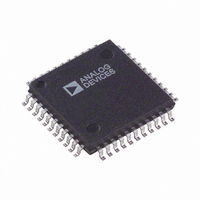AD6640AST Analog Devices Inc, AD6640AST Datasheet - Page 21

AD6640AST
Manufacturer Part Number
AD6640AST
Description
IC ADC 12BIT 65MSPS 44-LQFP
Manufacturer
Analog Devices Inc
Datasheet
1.AD6640STPCB.pdf
(24 pages)
Specifications of AD6640AST
Rohs Status
RoHS non-compliant
Function
A/D Converter
Rf Type
Cellular/PCS, GPS
Secondary Attributes
12 Bit, 65MSPS
Package / Case
44-LQFP
Available stocks
Company
Part Number
Manufacturer
Quantity
Price
Company:
Part Number:
AD6640AST
Manufacturer:
AD
Quantity:
13 888
Company:
Part Number:
AD6640AST
Manufacturer:
ADI
Quantity:
240
Part Number:
AD6640ASTZ
Manufacturer:
ADI/亚德诺
Quantity:
20 000
REV. A
Receiver Example
To determine how the ADC performance relates to overall receiver
sensitivity, the simple receiver in Figure 32 will be examined.
This example assumes that the overall down conversion process
can be grouped into one set of specifications, instead of individu-
ally examining all components within the system and summing
them together. Although a more detailed analysis should be employed
in a real design, this model will provide a good approximation.
In examining a wideband digital receiver, several considerations
must be applied. Although other specifications are important,
receiver sensitivity determines the absolute limits of a radio
excluding the effects of other outside influences. Assuming that
receiver sensitivity is limited by noise and not adjacent signal
strength, several sources of noise can be identified and their
overall contribution to receiver sensitivity calculated.
The first noise calculation to make is based on the signal bandwidth
at the antenna. In a typical broadband cellular receiver, the
IF bandwidth is 12.5 MHz. Given that the power of noise in a
given bandwidth is defined by P
k = 1.38 × 10
temperature, this gives an input noise power of 5.18 × 10
–102.86 dBm. If our receiver front end has a gain of 30 dB and
a noise figure of 10 dB, then the total noise presented to the ADC
input becomes –62.86 dBm (–102.86 + 30 + 10) or 0.16 mV rms.
Comparing receiver noise to dither required for good SFDR,
we see that in this example, our receiver supplies about 3% of
the dither required for good SFDR.
FROM
RF/IF
(SEE FIGURE 30)
NOISE SOURCE
Figure 31. Using the AD6640 with Dither
BW =12.5MHz
GAIN = 30dB
NF = 10dB
REF IN
–23
RF/IF
IF AMP
is Boltzman’s constant, and T = 300k is absolute
Figure 32. Receiver Analysis
BPF
LPF
AD6640
ENCODE
COMBINER
0.1 F
n
= kTB, where B is bandwidth,
SINGLE CHANNEL
CHANNELIZER
BW = 30kHz
0.01 F
61.44MHz
V
AIN
AIN
REF
AD6640
DSP
–14
W or
–21–
Based on a typical ADC SNR specification of 68 dB, the equiva-
lent internal converter noise is 0.140 mV rms. Therefore, total
broadband noise is 0.21 mV rms. Before processing gain, this is an
equivalent SNR (with respect to full scale) of 64.5 dB. Assuming
a 30 kHz AMPS signal and a sample rate of 61.44 MSPS, the
SNR through processing gain is increased by approximately
33 dB to 97.5 dB. However, if eight strong and equal signals are
present in the ADC bandwidth, then each must be placed 18 dB
below full scale to prevent ADC overdrive. Therefore 18 dB of
range is given away and the carrier-to-noise ratio (C/N) is reduced
to 79.5 dB.
Assuming that the C/N ratio must be 10 dB or better for accurate
demodulation, one of the eight signals may be reduced by 66.5 dB
before demodulation becomes unreliable. At this point, the input
signal power would be –90.5 dBm. Referenced to the antenna,
this is –120.5 dBm.
To improve sensitivity, several things can be done. First, the noise
figure of the receiver can be reduced. Since front end noise domi-
nates the 0.16 mV rms, each dB reduction in noise figure translates
to an additional dB of sensitivity. Second, providing broadband
AGC can improve sensitivity by the range of the AGC. However,
the AGC would only provide useful improvements if all in-band
signals were kept to an absolute minimal power level so that
AGC could be kept near the maximum gain.
This noise limited example does not adequately demonstrate the
true limitations in a wideband receiver. Other limitations such
as SFDR are more restrictive than SNR and noise. Assume that
the analog-to-digital converter has an SFDR specification of
–80 dBFS or –76 dBm (full scale = +4 dBm). Also assume that
a tolerable carrier-to-interferer (C/I) (different from C/N) ratio
is 18 dB. This means that the minimum signal level is –62 dBFS
(–80 plus 18) or –58 dBm. At the antenna, this is –88 dBm.
Therefore, as can be seen, SFDR (single or multi-tone) would
limit receiver performance in this example. However, as shown
previously, SFDR can be greatly improved through the use of
dither (TPCs 13 and 16). In many cases, the addition of the
out-of-band dither can improve receiver sensitivity nearly to that
limited by thermal noise.
IF Sampling Using the AD6640 as a Mix-Down Stage
Since performance of the AD6640 extends beyond the baseband
region into the third Nyquist zone, the converter has many uses
as a mix-down converter in both narrow-band and wideband
applications. This application is called band-pass sampling. Doing
this has several positive implications in terms of the selection of
the IF drive amplifier. Not only is filtering a bit easier, the selection
of drive amplifiers is extended to classical IF gain blocks. In the
third Nyquist zone and above, the second and third harmonics
are easily filtered with a band-pass filter. Now only in-band
spurs that result from third order products are important.
AD6640







